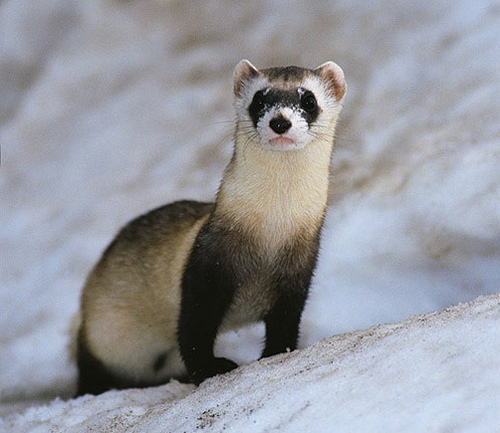 |
| Black Footed Ferret |
Description and biology
The black–footed ferret is a member of the weasel family (other members include weasels, martens, fishers, otters, minks, wolverines, and skunks). Similar in size to a mink, the back–footed ferret has a long, slender body covered in short, pale yellow fur.
On its throat and belly, the fur is nearly white. The animal has a brownish head, a brownish–black mask across its eyes, black feet and legs, and a black tip on its tail.
An average black–footed ferret has a body length of 18 to 22 inches (46 to 59 centimeters) and a tail length of 4.5 to 5.5 inches (11.5 to 14 centimeters). It weighs 18 to 36 ounces (510 to 1,021 grams).
  |
Black–footed ferrets prey on prairie dogs and live in prairie dog burrows. They hunt at night and are rarely active above ground during the day. Ferrets also eat mice, voles, ground squirrels, gophers, birds, and insects. They are preyed upon by great–horned owls, golden eagles, coyotes, and badgers.
Ferrets are solitary animals. They move around a territorial range of about 100 acres (40 hectares), which they mark with musk from scent glands. Males often have a larger range than females. The two sexes come together only to mate in March and April. After a gestation (pregnancy) period of 41 to 45 days, a female black–footed ferret gives birth to three to five infants, called kits.
The kits do not come out of the burrow until they are six weeks old. Then the mother separates the kits into different burrows, where they learn to take care of themselves. By early fall, they are on their own. Most kits do not survive their first year, and most adult ferrets do not live more than a few years.
Habitat and current distribution
Black–footed ferrets once ranged throughout the Great Plains—from Texas to southern Saskatchewan, Canada, and from the Rocky Mountains to the Dakotas, Nebraska, and Kansas. Considered one of the most endangered mammals in the United States, the black–footed ferret did not exist in the wild between 1987 and 1991.
History and conservation measures
When American pioneers moved west across the plains in the nineteenth and early twentieth centuries, they destroyed prairie dog habitat in order to create land for livestock and agriculture. The use of poison and hunting and habitat destruction reduced the prairie dog population by 90 percent.
As prairie dogs and their habitat disappeared, so did the food sources and habitat for black–footed ferrets. A severe plague of canine distemper (viral disease) in the 1950s further reduced the small number of remaining black–footed ferrets.
Because no black–footed ferrets were found in the wild between 1972 and 1981, the animal was thought to be extinct. However, in 1981, a small population of ferrets was discovered near Meeteetse, Wyoming. The population increased over the next few years, but an outbreak of canine distemper in 1985 severely threatened the survival of the species.
In 1987, the U.S. Fish and Wildlife Service (USFWS) placed the last 18 known wild black–footed ferrets in a captive breeding facility. The goal of this program is to maintain a breeding population of black–footed ferrets in captivity and to return their offspring to the wild.
In 1991, 49 captive–bred, young ferrets were released into the Shirley Basin in Wyoming. Several of these animals survived the winter and bred successfully. Since 1991, 200 captive–bred ferrets have been released in Wyoming.
The captive breeding programs that followed have been highly successful. By 1998, the captive breeding programs were producing record–breaking numbers of kits, many of which were reintroduced to the wilderness. In 1998 alone, 94 kits were released in South Dakota’s Conata Basin/Badlands National Park.
Montana received 77 kits in two sites, Arizona received 29, New Mexico 7, and 10 went to an experimental area in Colorado and Utah. Ferrets have also been successfully released in the wild in Mexico. All of these reintroduced ferret populations have produced healthy numbers of litters in the wild.
Between South Dakota and Montana, an estimated 100 kits were born in the wild in 1998 alone. In the fall of 2002, ferrets were released at a new managed prairie dog/black–footed ferret site on the Rosebud Sioux Reservation in South Dakota.
The tribe has been active in conservation of the prairie ecosystems (the ecological community, including plants, animals, and microorganisms, considered together with their environment), and will take a leading role in ferret recovery on their lands, where a population of 200–400 ferrets is expected.
The U.S. Fish and Wildlife Service reports that there are limited sites in North America with suitable prairie dog populations to support the self–sustaining ferret population currently being released in the wild.
Further work on managing prairie dog populations and their habitat is needed in order to keep up the progress made on the recovery of the black–footed ferret in the wild.
